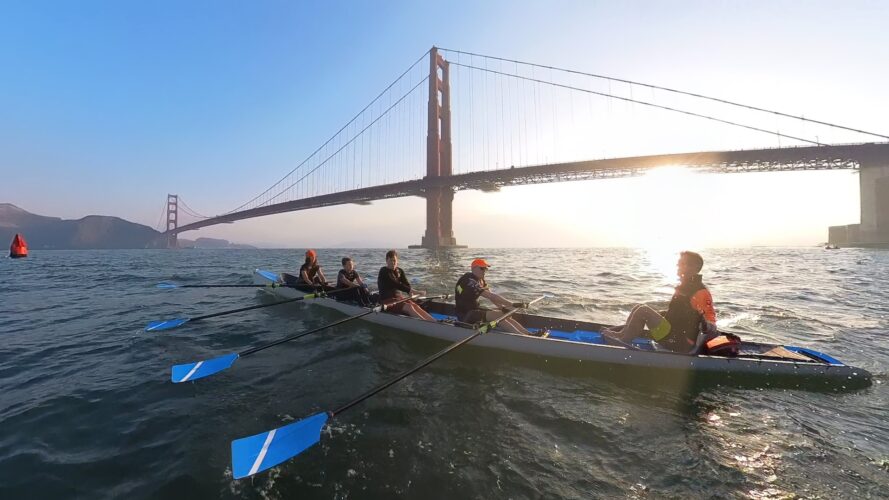The Dolphin Club has two coastal quads for adult team rowing and racing on San Francisco Bay. Both boats are great for rowing with others, improving your stroke, and training for competition.
Outings are scheduled somewhat organically. We go out frequently on Friday mornings, Sunday mornings and other days throughout the week. Novice rowers are welcome. Let us know you’re interested by filling out the ‘Training Request Form‘ and select Team Rowing.

Your First Outing
It’s fun rowing in a group. There’s an energy that comes from not letting your crew-mates down, and a camaraderie from the shared experience. But, please, come prepared:
- Meet on Time
There’s nothing worse than a crew ready to go and waiting for someone to show up. Rowing relies on teamwork, and teamwork means showing up for your team. For every outing there’ll be the hands-on time. This is the time we do our briefing. Please be there for that – there’s no harm in being early! - Be Physically Fit
The quad is similar to our coastal rowing boats, and requires some agility to get in and out of. You don’t need to be an athlete, but you should be in fairly good shape so you can keep up with the crew. - Practice your Rowing Technique
Rowing with other people will help you improve your rowing technique. But it’ll help if you come to the boat with the basics of your rowing stroke sorted. If you’re coming from the wooden boats, we recommend you practice in our Spirit Whitehalls which use standard length lightweight oars which can be feathered properly. - Dress to row
It’s best to dress in tight fitting synthetic layers. You’ll be getting a workout so you will warm up as you row. You may get splashed with water along the way so synthetic or smart-wool layers are better than cotton. Your clothes should be fairly tight fitting so that they don’t snag your oar handles. You can wear lightweight shoes in the boat, or you can row barefoot, or in socks.
When you meet your coxswain will assign you a seat. If it’s your first time, you’ll typically row in the middle of the boat. You’ll be shown how to set up and adjust your seat, and get ready for your row.
Under Way: Know your Terminology
Rowing as a team brings its own terminology and commands. Familiarize yourself before your first outing.
- Port Oar, Starboard Oar
Port is on the left when facing the bow of the boat. But since you’ll be facing the stern, port is actually your right oar. If the cox asks you to row harder with the port oar, pull harder with your right side. If the starboard oar, that’ll be your left side. - Bow seat, Stroke seat
The stroke is often the most experienced, consistent rower in the boat. The stroke sets the rhythm. Everyone follows the stroke….. follow the stroke over the person in front of you. Follow their body more than the oars. The bow seat often has a good view of the crew and is likely of more experience and able to coach newer rowers in seat two and three. - “Count off when ready“
After an interruption or break in rowing, the cox will likely ask to count off when ready. Starting from bow – seat 1, count off once your ready. - “Ready to row“
Once everyone is ready the cox will give warning to prepare to row. Some coxwains prefer people to start from the catch; others prefer to start from the finish. Be on the listen for ‘ready at the catch’, or ‘ready at the finish’ - “Paddle“
Paddling is very gentle rowing, without bending legs. Typically done in close quarter maneuvers with other boats or the dock. - Arms only, Arms and Back, Arms, Back and Legs
To achieve rhythm in the boat, your cox will often start with asking you to row with just your arms to make it easier to get in sync. - Quarter slide, Half Slide, Full Slide
As you transition into rowing with your legs, the cox may ask you to row at quarter slide or half slide… here you limit your leg motion, and focus on staying in sync with the crew. At full slide your rowing with your full body, arms and legs. - “Way Enough“
This is the command to stop rowing. It’s usually given with some warning…. “In 2, way enough…. 1, 2, way enough”. For reference, ‘way‘ is the momentum of the boat moving through the water. - “Hold Water“
Hold water is the command to place your blades in the water and help stop the boat. This is often given without much warning in order to stop the boat from hitting something. At speed you should insert your blades at an angle to help break the pressure rather than the oar.
Preparing the Boat
It takes a polished crew about 15mins to set up the boat and get it ready for launch.
- (Storm – White Quad) Remove the boat from the rack and lower to the dolly.
Place the removable dolly underneath the stroke seat. Lower the rack so the boat rests on the dolly. Attach the straps. Be careful to ensure no sharp edges on the dolly come into contact with the shell of the boat. Tighten the straps. Wheel the boat out of the boathouse, and support the bow with one of the wooden slings. - (Storm – White Quad) Attach the riggers
Two people should go get the riggers for the boat and lock them in. Sometimes the pins are difficult to push in. Wiggle them, or use silicon lube. Do not hit them with your hand or a hammer. - (Storm – White Quad) Attach the rudder and set up the cox-box
This is typically the coxwain’s job. Details below. Test the cox box. Know how to turn it on and to use it. - Bring oars out to the apron.
The boat is ideally configured to use the pink croaker oars. Use these if available. - Configure & Safety Check.
Find your seat, and check all looks ok. Seat should slide back and forth evenly. Oarlocks should be fastened and rotate. Double check the pins on the riggers are fully engaged. Adjust footrests before you get in the boat to speed up the process. Coxwain, do a final safety check – ensure lugs and hatches are sealed, and scuppers up before launching.
Launching
- Roll the boat out to the end of the dock.
Check that the dock is clear and raised. The boat can be rolled down the dock by one person holding from the bow, but it’s easier if there are two. Roll the boat out so that the stern of the boat overhangs the end of the apron. - Remove the dolly
Rest the bow on the apron. Have two people support the stern of the boat while another removes the dolly. Dolly can then be brought back and placed upside down on the main dock. - Insert oars before launching
We find it is quicker and more stable to set up the oars in the boat before launch. Ensure the oars are configured correctly with the port oar in the port oarlock and the pins facing forward. Coxwain should double check to make sure all oars are inserted correctly. Place so the oars blades are inside the boat and the handles outside. - Launch the boat
This is best done by one strong person from the handle at the bow. Try to minimize the hulls scraping on the bottom of the apron. Let the wind and current direct the stern of the boat. It will usually go right to let the bow face west for launch. - Find your seats
Rowers enter the boat from the bow. Seat 1 is the first. Once seat one is situated, the nose of the boat is moved forward and the next rower gets in. As soon as possible, rowers should extend their oars with blades up and resting on the water to maintain balance. - Ready to row
The last person to get in the boat is the coxwain. Seats 3 and 4 should hold onto the dock while the cox enters the boat and connects the coxbox.
Recovery and Put-Away
Landing at the dock is done under the call of the coxswain. Bow seat should be ready to ship oars and bring the boat alongside. Stroke seat does much of the final rowing.
Seat 1 should be first to get out. Remove oars, and then hold the boat to allow subsequent seats to do the same.
If the current is strong, the boat may need to be spun around to make it easier to drag up onto the dock fully perpendicular.
Once on the dock, the apron should be raised, and water drained out from the scuppers. Two people should lift the stern of the boat and refasten the dolly before rolling the boat back up the dock.
Riggers need to be removed and everything rinsed down with fresh water. Rudder and seats need to be removed and put away. The boat should be dried and then put away in the racks with the guts facing down. Oars put away too. The full crew needs to be on hand to lift the boat to the racks. Please don’t leave until this is done.
Additional Information
Warning for Rough Water
Our quad is not designed to be rowed in rough water. Water coming over the bow can quickly inundate the boat. If the boat does start to collect water, there are self-draining scuppers by the feet of the coxwain and in front of the foot stretchers on seat 2. These should be opened while the boat is moving to drain
Do not remove the pool noodles stuffed in the hull. These provide flotation and displacement in the event you get inundated with water to keep the gunwhales well above the water line.
Rigging the Rudder
Rigging for use without a cox
The quad can be configured for use without a coxwain.
Rigging as a sweep
Decide if rowing in sweeps or sculling configuration, locate riggers and rudder equipment.
Where Can We Go?
Four seat rowing is both the past and future of rowing at the Dolphin Club. For many years, racing at the club was all done in four seat boats until the late 1950s where rowing gravitated out to the flat waters of Lake Merced.

With the growing popularity of coastal rowing around the world, we’re likely to see a return to four-seat rowing on San Francisco Bay in the years ahead.
